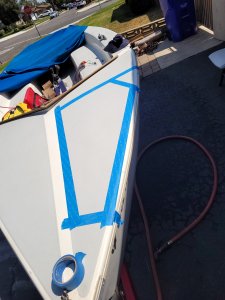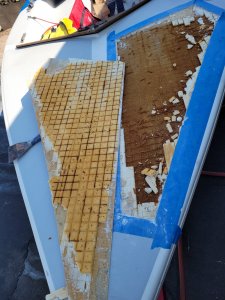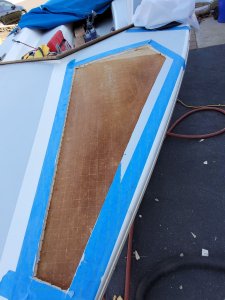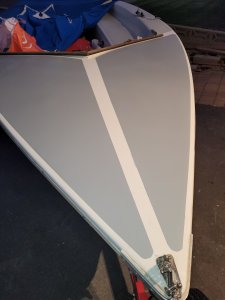I have a Capri 14.2 with a soft deck that needs repair. I think it could be caused by physical damage and not water intrusion. Damage does not extend to the edge of boat or anywhere screws from mast or wood are. The soft spot is under the non-skid on the deck. I am guessing the deck is: top -gelcoat/ middle-wood/ bottom-polyester fiberglass. Any advice for repair or knowledge of what materials the deck is made of would be appreciated.
Navigation
Install the app
How to install the app on iOS
Follow along with the video below to see how to install our site as a web app on your home screen.

Note: This feature currently requires accessing the site using the built-in Safari browser.
More options
You are using an out of date browser. It may not display this or other websites correctly.
You should upgrade or use an alternative browser.
You should upgrade or use an alternative browser.
Capri 14.2 Mod 1 Deck Repair
- Thread starter Breezy
- Start date
Kerrcat14.2K
Member
Soft decks can be indicators of several problems, some serious, some not so much. I suggest that you research fiberglass boat repairs and study or buy some of the excellent articles, books, on fiberglass work.
The deck is gelcoated fiberglass (including matting and resin) laid over either marine plywood, a balsa core, or some other core. Older decks are probably balsa cored. The underlaying bottom skin is fiberglass/resin and fiberglass cloth and/or chopped fiberglass mat material. The sandwich is really held together by the resin impregnating process. The last deck which I repaired was on a Cape Dory Typhoon (about 19 feet) which was delaminating and also experiencing core rot due to moisture penetration. It was a 1974 model and had a few through hull and mounted fittings. It took only a little lack of maintenance by the previous owner to allow the moisture to seep throughout the core. The deck was mostly nonskid patterned with smooth surfaces around the edges, maybe two inches wide. Short story is that we used a circular saw and a Dremel tool to cut around the deck at the edge of the non slip pattern, cutting only as deep as the top sandwich layer/skin. We were able to lift off the layer like taking off a skin. The balsa core was rotting and looked more like charcoal. The bottom skin was holding everything together. We totally removed the balsa that was exposed and gouged out as much as possible under the smooth surface. Using the top skin as a pattern, we shaped marine plywood, same thickness as the original balsa, to fit the area we had exposed. The new core was resin coated along with fiberglass cloth and glued to the bottom sandwich layer. Remaining exposed voids were filled with resin/epoxy/cloth. Then, the top skin was glued to the new core using resin epoxy and fiberglass cloth and shreds. The gap between the smooth edge and the skin was sealed/filled with epoxy mixed with some small amount of filler. Sanding and fairing finished off the surface. All surfaces were prepped as much as possible and the deck was painted with Interlux marine paint. Later, through hulls, fittings, etc. were replaced and properly bedded. We used West System epoxy/resin/fiberglass system. This same process was repeated on the stern deck, and some of the side areas. And, this is a short version of what was involved. Boat looked great when finished, was very solid, no seams were showing, and gave no problems as long as I kept it; I sold it a few years ago. Which led to me ordering a 2016 Catalina 14.2 with keel; best small dinghy sailer I have ever owned, rigged basically just like the Cape Dory and it's predecessor Tanzer 22.
Also, look into minor deck delamination information and you may find that injections of resin in holes which you carefully drill will solidify minor delamination areas.
Point to all of this is, consider your abilities/experience with fiberglassing techniques and study, study, study. The above worked because the inner liner/bottom skin was solid and in good shape, and we were able to examine all areas for strength and flex integrity.
Good luck!
The deck is gelcoated fiberglass (including matting and resin) laid over either marine plywood, a balsa core, or some other core. Older decks are probably balsa cored. The underlaying bottom skin is fiberglass/resin and fiberglass cloth and/or chopped fiberglass mat material. The sandwich is really held together by the resin impregnating process. The last deck which I repaired was on a Cape Dory Typhoon (about 19 feet) which was delaminating and also experiencing core rot due to moisture penetration. It was a 1974 model and had a few through hull and mounted fittings. It took only a little lack of maintenance by the previous owner to allow the moisture to seep throughout the core. The deck was mostly nonskid patterned with smooth surfaces around the edges, maybe two inches wide. Short story is that we used a circular saw and a Dremel tool to cut around the deck at the edge of the non slip pattern, cutting only as deep as the top sandwich layer/skin. We were able to lift off the layer like taking off a skin. The balsa core was rotting and looked more like charcoal. The bottom skin was holding everything together. We totally removed the balsa that was exposed and gouged out as much as possible under the smooth surface. Using the top skin as a pattern, we shaped marine plywood, same thickness as the original balsa, to fit the area we had exposed. The new core was resin coated along with fiberglass cloth and glued to the bottom sandwich layer. Remaining exposed voids were filled with resin/epoxy/cloth. Then, the top skin was glued to the new core using resin epoxy and fiberglass cloth and shreds. The gap between the smooth edge and the skin was sealed/filled with epoxy mixed with some small amount of filler. Sanding and fairing finished off the surface. All surfaces were prepped as much as possible and the deck was painted with Interlux marine paint. Later, through hulls, fittings, etc. were replaced and properly bedded. We used West System epoxy/resin/fiberglass system. This same process was repeated on the stern deck, and some of the side areas. And, this is a short version of what was involved. Boat looked great when finished, was very solid, no seams were showing, and gave no problems as long as I kept it; I sold it a few years ago. Which led to me ordering a 2016 Catalina 14.2 with keel; best small dinghy sailer I have ever owned, rigged basically just like the Cape Dory and it's predecessor Tanzer 22.
Also, look into minor deck delamination information and you may find that injections of resin in holes which you carefully drill will solidify minor delamination areas.
Point to all of this is, consider your abilities/experience with fiberglassing techniques and study, study, study. The above worked because the inner liner/bottom skin was solid and in good shape, and we were able to examine all areas for strength and flex integrity.
Good luck!
As you mentioned getting a fixed keel model, I'll offer my take on the pros and cons to swing board vs. fixed keel model Capri 14.2's.
Pro's for swing keel..........
Easier to trailer, launch, and retrieve. Lighter weight. These things mean a lot if your'e a single hander. Climb in/out of boat while on trailer. Less visible to neighbors if you store on your property. Lighter weight also makes boat much easier to drag around your property with a hand dolly.
Pros for fixed keel.......
Although I've never sailed one certainly must be far superior in pointing, tracking, roll stability when docked. If I had lake front property with dock I wold surely get a fixed keel model and keep it in the water all season. But if you need to pull in/out and store on trailer there's no better way to go than with swing model.
Swing version also forces one to become a better sailor. Either that or end up in the drink on a sporty day! And it may be a bit faster because of less drag below......
Cheers!
Pro's for swing keel..........
Easier to trailer, launch, and retrieve. Lighter weight. These things mean a lot if your'e a single hander. Climb in/out of boat while on trailer. Less visible to neighbors if you store on your property. Lighter weight also makes boat much easier to drag around your property with a hand dolly.
Pros for fixed keel.......
Although I've never sailed one certainly must be far superior in pointing, tracking, roll stability when docked. If I had lake front property with dock I wold surely get a fixed keel model and keep it in the water all season. But if you need to pull in/out and store on trailer there's no better way to go than with swing model.
Swing version also forces one to become a better sailor. Either that or end up in the drink on a sporty day! And it may be a bit faster because of less drag below......
Cheers!
Kerrcat14.2K
Member
Aquaman is correct with his analysis. After sailing for over 50 years, being 73 years old, I wanted something to keep at the dock (floating docks only on Kerr Lake, a variable level lake), and wanted more stability. I've sailed three daggerboard boats, two fixed or shoal keel boats (19 to 23 feet) and two centerboarders before downsizing to the Cat14.2. The fixed keel on the 14.2 adds two hundred pounds of ballast and extends two feet below the hull, it's wider but shorter than the centerboard. Also uses a fixed rudder as opposed to a kick up rudder. I wanted to draw only two feet of water at the dock and wanted stability both while sailing as well as when left in the water at the dock. And, the cockpit is much more open without the center board well and lines. I added cleats at the stern on both sides as well as a mooring cleat on the forward deck. So, with bumpers, dock lines, and spring lines the boat rides well at the dock. The roller furling jib, single line main reefing, and modified lazy jacks also help with single handing. I do need a ladder to access the boat when on the trailer and need to disconnect the trailer from the vehicle when launching and retrieving annualy (with a chain/rope attachment to the hitch) so that the trailer can be partially sunk to allow loading and unloading. I fell like the keel model points a little less well than the centerboarder due to the limit on depth of the keel but that may be somewhat compensated for by the width of the keel. Back in the day, my Tanzer 16 centerboarder could be popped up onto a plane downwind with two or more people sailing and careful handling. I don't think that the 14.2 will plane easily with the extra weight and drag of the keel but since I only single hand I will never know. But, overall I continue to enjoy the 14.2 since it is essentially rigged just like the other fixed keel boats and delivers great performance without feeling too much instability. The Honda 2.3 gets me home when the wind dies. Good sailing!!!
One other footnote about the pointing ability of my swing keel Mod 1. When there's light air I sometimes just motor sail (Minkota trolling motor) with jib only . It's much easier than setting up main also. If the wind picks up I get some decent action, and it points surprisingly well!
The pic shows how I position the Minkota, it's totally out of the way there. Also see the Baby Bob on top of the mast. Haven't dumped her yet, but surely someday!
See at the speed shown, the deep rudder/keel bite probably does mean somewhat less sideslip and better pointing compared to the fixed keel guy. If I weighed 150 instead of 190 probably couldn't get as aggressive. But there again, I would much rather take fixed keel out on larger bodies of water in sporty conditions.........
The pic shows how I position the Minkota, it's totally out of the way there. Also see the Baby Bob on top of the mast. Haven't dumped her yet, but surely someday!
See at the speed shown, the deep rudder/keel bite probably does mean somewhat less sideslip and better pointing compared to the fixed keel guy. If I weighed 150 instead of 190 probably couldn't get as aggressive. But there again, I would much rather take fixed keel out on larger bodies of water in sporty conditions.........
Attachments
See pictures of repair. The deck is foam core between fiberglass. One side of the deck I did an injection of thickened resin and the other side of deck I replaced the core. Time will tell which method works best. Both feel strong. Finished with non-skid paint.




